Lava Xolo X900 Review - The First Intel Medfield Phone
by Brian Klug on April 25, 2012 6:00 AM ESTBattery Life
Nailing performance is one thing, but in order to really sell Medfield and other upcoming SoCs to OEMs, Intel has to deliver battery life and power consumption that's competitive. It's about performance/power in the SoC space. First, it's worthwhile to note that the X900 includes a relatively small battery, at just 5.4 Whr. Of late, batteries over 6 Whr seems like the norm, and I'm told that future designs including the Motorola phone will probably include larger ones. It's just good to have that frame of reference and this chart should help:
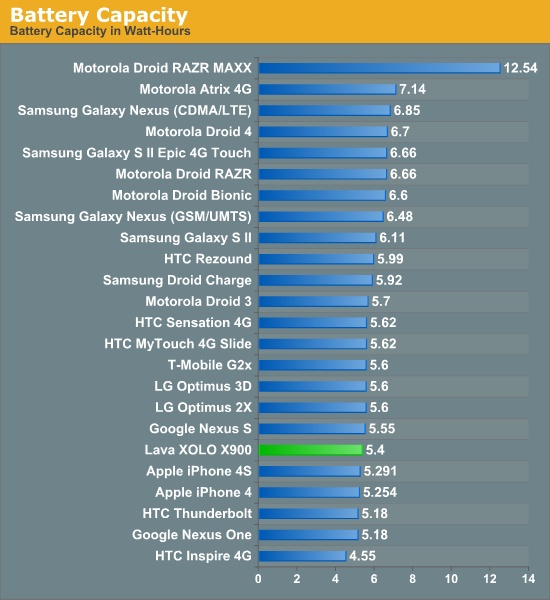
Intel notes battery life in their own X900 announcement blast as being around 5 hours of continuous 3G browsing and 8 hours of talk time. Our own numbers end up being pretty darn close, at 4.6 hours and 8.5 hours for those two metrics, respectively.
As a reminder, the browsing tests happen at 200 nits and consist of a few dozen pages loaded endlessly over WCDMA or WiFi (depending on the test) until the phone powers off. The WiFi hotspot tethering test consists of a single attached client streaming 128 kbps MP3 audio and loading four tabs of the page loading test through the handset over WCDMA with the display off.
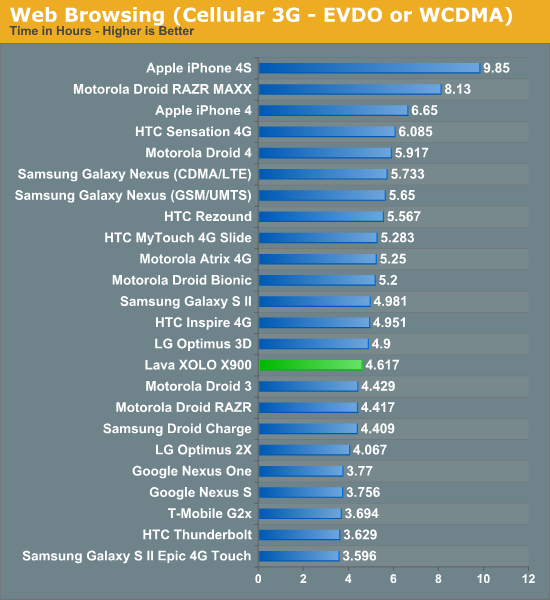
As a smartphone the X900 does a bit below average here, but as we mentioned it also has an unusually small battery for a modern flagship Android smartphone. If we divide battery life by battery capacity, we can get a better idea for how the Medfield platform compares to the competition:
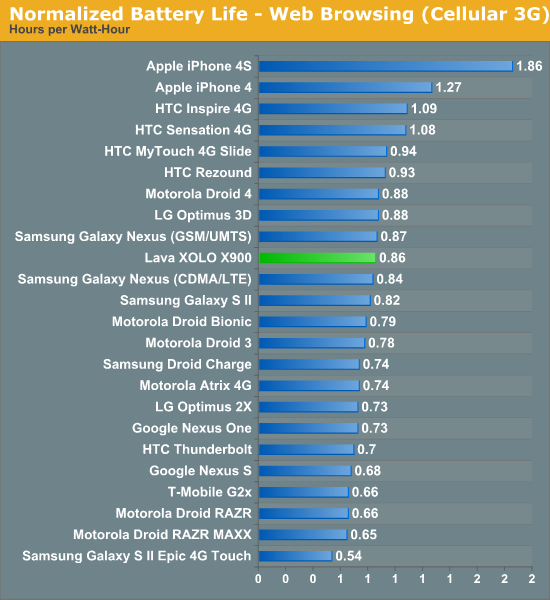
Normalizing for battery capacity, the X900 actually does a bit above average. In other words, the Medfield platform appears to be just as power efficient as some of the newer OMAP 4 based smartphones.
On WiFi the situation is no different:
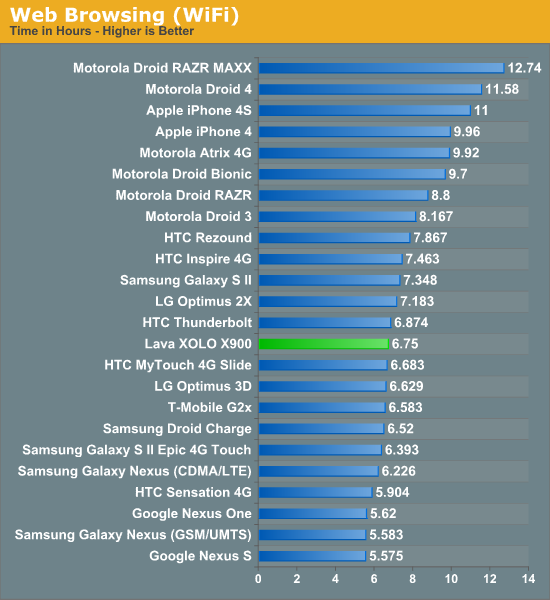
Again we see reasonable numbers for the X900 but nothing stellar. The good news is that the whole x86 can't be power efficient argument appears to be completely debunked with the release of a single device. To move up in the charts however, Intel needs to outfit its reference design with a bigger battery - something I've heard is coming with the Z2580's FFRD. The normalized results put the X900 at the middle of the pack:
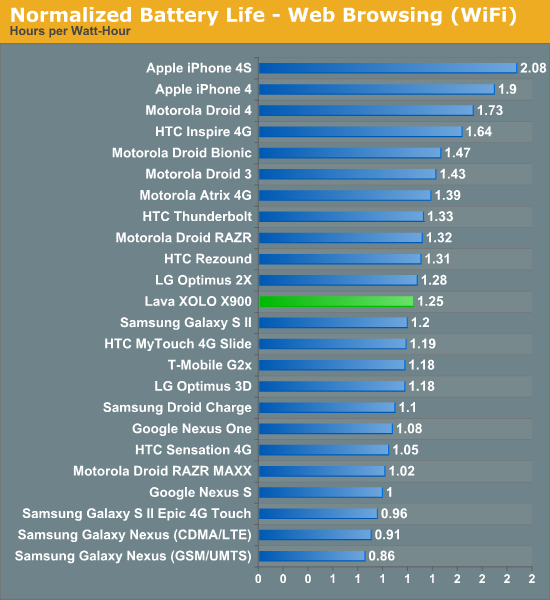
We see similar results in our talk time and 3G hotspot tests:

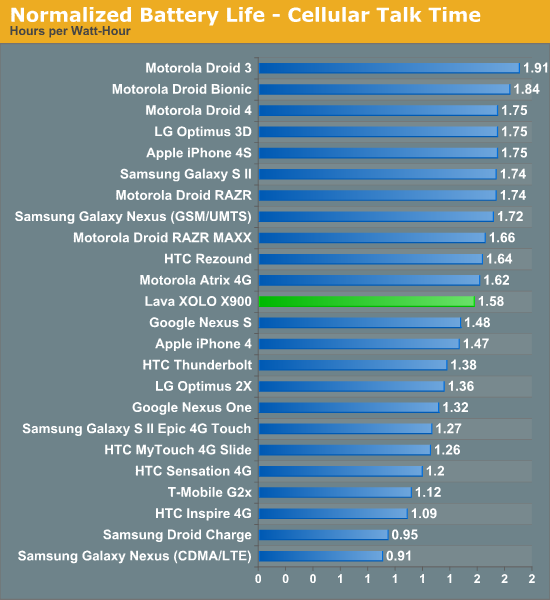
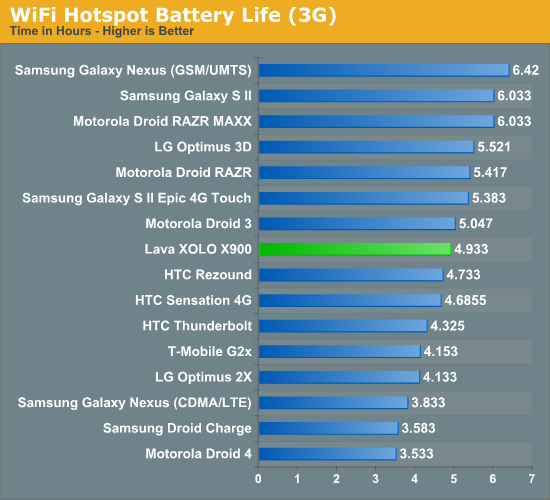
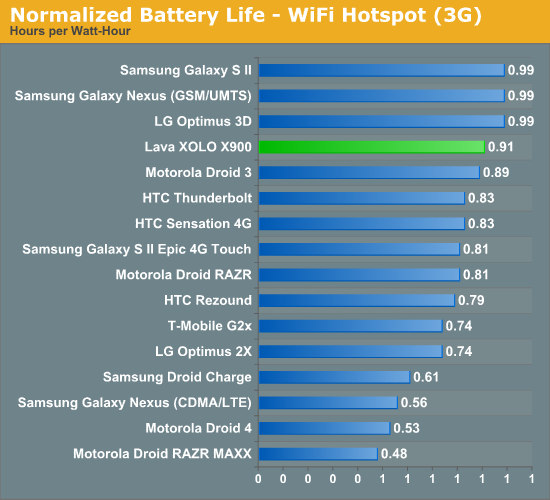










106 Comments
View All Comments
iwod - Wednesday, April 25, 2012 - link
Since Phone Maker can just buy a reference design from ARM, and all other parts, then Fab them with TSMC, the only cost is a Engineering Team and Fab Cost. For Phone Maker with Large Volume, The Total cost of SoC is much cheaper then say buying from Nvidia.SoC Margin is much smaller then what they used to get with Desktop and Laptop Chip. So unless Intel's smartphone SoC is MUCH faster, otherwise there just aren't any incentive of changing over.
ExarKun333 - Wednesday, April 25, 2012 - link
I doubt you know the exact pricing of all the options. If NV and Intel were not competitive competitive price-wise, they wouldn't be in the market...fm123 - Thursday, April 26, 2012 - link
Not necessarily true. Since Intel could be using it as a loss leader to take marketshare even at 0 profit. The desktop non-SoC Atom pricing starts around $40 (based on their pricelist), while something like Tegra2 is in the below $20 and Tegra3 supposedly in the $20's.Intel can throw lots of money at this and not make any for quite a while. Since part of the plan was likely to create a reference design anyone could sell, that is apparently what they are doing.
UltraTech79 - Thursday, April 26, 2012 - link
None of what you said made "If NV and Intel were not competitive competitive price-wise, they wouldn't be in the market..." an untrue statement.fm123 - Friday, April 27, 2012 - link
If Intel "sells" for little to no profit, then it could be price competitive for the people buying it. Nvidia has to make some profit, because they are far smaller with less bank account than Intel. Intel's own current pricing of Atom shows they are way out there based on their current operating margins, but again that's not their initial goal anyway.Given that Intel had to spend lots to develop the reference design and port Android, they clearly invested massive R&D into the project. They have offered this service to anyone wanting to sell the phone without extra cost, you can't take an Nvidia reference and sell it as they don't do final designs and software. So they don't care about the time schedule as long as they can get marketshare, but they offer a fully manufacturable product, just like GPU reference design boards AMD and Nvidia offer.
This was the argument I always brought up, Intel has a specific margin range they sell at. Mobile products are lower margin than they would prefer, but they need to take away market share from competition, it's similar to getting greater margins.
kuroxp - Monday, May 21, 2012 - link
After that big EU fine, I'd be surprised if Intel sold their stuff below cost....Lucian Armasu - Friday, April 27, 2012 - link
Could they be doing price dumping? Either way, check this out:"Intel's Oak Trail platform, paired Atom Z670 CPU (US$75) with SM35 chipsets (US$20) for tablet PC machine, is priced at US$95, already accounting for about 40% of the total cost of a tablet PC, even with a 70-80% discount, the platform is still far less attractive than Nvidia's Tegra 2 at around US$20."
http://www.digitimes.com/news/a20110815PD216.html
The CPU from Xolo is from the same Z class, so it should cost about the same, especially with it being newer and all.
B3an - Wednesday, April 25, 2012 - link
It's too thick, average performance, average battery and dont compare to Krait / A15 ARM SoC's which was really needed being as A9 is old news. But atleast it's a reasonable attempt this time. Unlike all other failed Intel attempts in this area. So quite good-ish news for Win 8 tablets...I just hope the dual core version for Win 8 tablets is clocked considerably higher because i'll be get a Win 8 tablet but the question is which one, and i'd like it to have good performance compared to ARM based alternatives because i'd like to run x86 software, but if the WinRT ARM alternatives are better by a large margin it might be enough to make me forget about x86.
Latzara - Wednesday, April 25, 2012 - link
Too thick - it's thicker than the ones it's compared with here - but calling 1.1 cm 'Too thick' compared to 0.95 or similar is preposterous cause it basically feels the same in your hand and usage wise it's no differentB3an - Wednesday, April 25, 2012 - link
Thats purely your opinion and i'm sure you're a minority. Many people are not even going to consider this because of it's thickness.When compared to nearly all other phones of similar performance/spec that have come out in 2012 this phone is likely thicker than atleast 98% of them. Even most phones from 2011 were often thinner. And it might be slight difference but it's easy to feel and see.